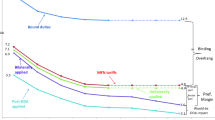Abstract
Since their implementation at the Uruguay Round, tariff rate quotas (TRQs) have become a widely used instrument of trade policy in agricultural trade. With almost 1,300 TRQs scheduled at the World Trade Organization, this paper will examine their economic effects more closely. First, the theoretical background of TRQs is examined. Then, a short overview of the Uruguay Round and their institutional background is given. We demonstrate that official statistics, which do not count TRQs as nontariff barriers, are at least highly misleading. Very often, their effects are the same as those of regular quotas, including redistributive effects. The prominent example of the European banana regime is used to illustrate all of these points.
Similar content being viewed by others
References
Abbott, P.; Morse, B. A. "Tariff Rate Quota Implementation and Administration by Developing Countries: A Summary of Findings," paper presented at the annual meeting of the International Agricultural Trade Research Consortium, December 1999.
Anderson, K. "Agriculture, Developing Countries, and the WTO Millennium Round," discussion paper, 99/28, Center for International Economic Studies, 1999.
Boughner, D. S.; de Gorter, H.The Economics of Two-Tier Tariff Rate Import Quotas and the Agreement on Agriculture in the WTO, Ithaca, NY: Cornell University, 1999.
Deodhar, S. Y.; Sheldon, I. M. "Is Foreign Trade (Im)perfectly Competitive?: An Analysis of the German Market for Banana Imports,"Journal of Agricultural Economics, 46, 3, 1995, pp. 336–48.
European Commission. "Commission Proposes to Modify the EU's Banana Regime," 〈http://europa.eu.int/comm/trade/miti/dispute/banana/0911bana.htm〉, November 10, 1999.
European Council. "Verordnung 404/93: rates vom 13 Februar 1993 über die gemeinsame marktorganisation für bananen,"Amtsblatt der Europäischen Gemeinschaften, 47, 1993.
Herrmann, R. "Economic Implications of the New European Banana Market Regime: The Case of Germany,"Jahrbücher für Nationalökonomie und Statistik, 218, 1/2, 1999, pp. 63–84.
Herrmann, R.; Kramb, M.; Mönnich, C. "The EU's Common Market Organization for Bananas and the WTO Panel Report," paper presented at the annual meeting of the International Agricultural Trade Research Consortium, December 1999.
Herrmann, R.; Sexton, R. "Redistributive Implications of the Tariff Rate Quota Policy: How Market Structure and Conduct Matter,"Discussion Papers in Agricultural Economics, 52, 1999.
Hudec, R. E. "Does the Agreement on Agriculture Work? Agricultural Disputes After the Uruguay Round," working paper, 98-2, International Agricultural Trade Research Consortium, 1998.
Josling, T.; Tangermann, S. "Implementation of the WTO Agreement on Agriculture and Developments for the Next Round of Negotiations,"European Review of Agricultural Economics, 26, 3, 1999, pp. 371–88.
Josling, T. E.; Tangermann, S.; Warley, T. K.Agriculture in the GATT, London, United Kingdom: Macmillan Press, 1996.
Koester, U. "The Redistributional Effects of the Common Agricultural Financial System,"European Review of Agricultural Economics, 4, 4, 1977, pp. 321–45.
Organization for Economic Cooperation and Development.Indicators of Tariff and Nontariff Barriers: Update, Paris, France: OECD, 1997.
Pedler, R. H. "The Fruit Companies and the Banana Trade Regime," in R. H. Pedler; M. P. C. M. van Schendelen, eds.,Lobbying the European Union: Companies, Trade Associations, and Issue Groups, Aldershot, United Kingdom: Dartmouth, 1994, pp. 667–91.
Skully, D. W. "The Economics of TRQ Administration," working paper, 99-6, International Agricultural Trade Research Consortium, 1999a.
__. "U.S. TRQs for Peanuts, Sugar, and Tobacco: Historical Allocation and Nondiscrimination," paper presented at the annual meeting of the International Agricultural Trade Research Consortium, December 1999b.
Tangermann, S. "Implementation of the Uruguay Round Agreement on Agriculture: Issues and Prospects,"Journal of Agricultural Economics, 47, 1996, pp. 315–37.
Thompson, S. R.; Herrmann, R.; Gohout, W. "Agricultural Market Liberalization and Instability of Domestic Agricultural Markets: The Case of the CAP,"American Journal of Agricultural Economics, 82, 3, 2000, pp. 718–26.
World Trade Organization. "The General Agreement on Tariffs and Trade," 〈http://www.wto.org/wto/legal/finalact.htm〉, 1986.
__. "Agreement on Agriculture," 〈http://www.wto.org/wto/legal/ finalact.htm〉, 1994.
__. "Sanitary and Phytosanitary Measures,"WTO Agreement Series, 1998.
__. "European Communities. Regime for the Importation, Sale, and Distribution of Bananas: Recourse to Article 21.5 by Ecuador," report, WT/DS27/RW/ECU, WTO, December 4, 1999.
Author information
Authors and Affiliations
Additional information
A first draft of this paper was presented at the International Atlantic Economic Conference, March 14–21, 2000, Munich, Germany. The results are part of the research project "The Influence of the Institutional Design on the Actual Impacts of Agricultural Trade Liberalization after GATT." Financial support by Volkswagen Stiftung is gratefully acknowledged.
Rights and permissions
About this article
Cite this article
Herrmann, R., Kramb, M. & Mönnich, C. Tariff rate quotas and the economic impact of agricultural trade liberalization in the world trade organization. International Advances in Economic Research 7, 1–19 (2001). https://doi.org/10.1007/BF02296588
Issue Date:
DOI: https://doi.org/10.1007/BF02296588




